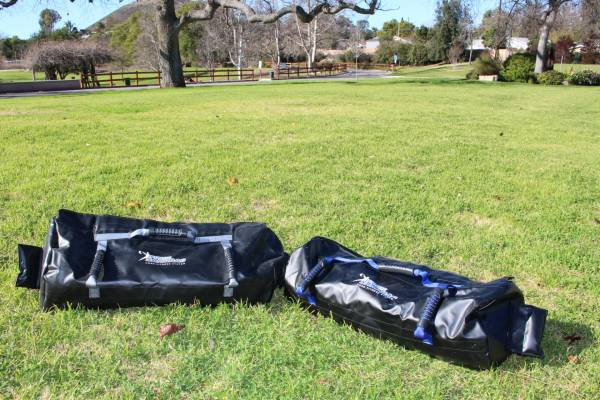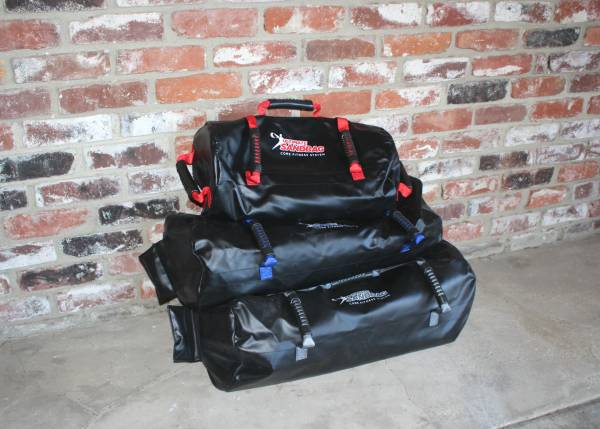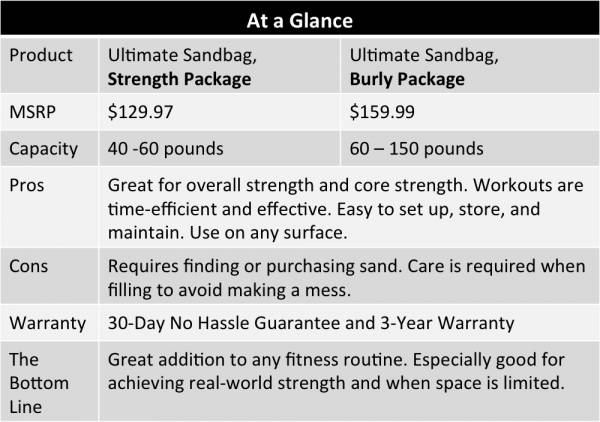Before getting started with Ultimate Sandbag (USB) and Dynamic Variable Resistance Training (DVRT), I did not really understand why there was a range of bag styles and sizes (Core, Power, Force, Strength, and Burly). Naively, I had thought that maybe I’d just get the biggest size and that would allow me the flexibility to do not only the big-bag stuff, but also everything each of the smaller bags could. I mean, if you just load it with less weight, wouldn’t a big bag work like a small one?
Well, I was mistaken. Turns out that buying a big sandbag and thinking it can do everything all the smaller-sized bags can do is a like buying a motor home and thinking it can do everything a sports car, sedan, and pickup truck can do. Each of the different sizes has it’s own characteristics and purpose.
So, as I wrote up earlier, I started with the Power USB. It’s been a great tool, and I keep it by my desk and use it pretty much every day. The Power bag is designed for a load between 10-40 pounds. Of course, being sort of thick-headed, I tend to approach these things in ways that I would scold any of my clients for, and I loaded it to 40 pounds right off the bat. As a result, as I began the DVRT program that’s included with each Ultimate Sandbag, I realized I was going to have to lighten the load or stick to more basic exercises and work my way up. I chose the latter, and that’s worked well for me. I’ve become competent moving the bag around and with many of the exercises in the DVRT program.
But, being me, I still wanted to get on with it and see what gnarly he-man manly challenge the heavier bags might offer. I’m a reasonably strong 55-year-old, with a max deadlift just north of 400 pounds, so I figured I could jump right to using the big bags. I ordered a Strength bag and a Burly bag.
Product Desciption
The Strength bag is USB’s second-largest in capacity, recommended for 40 – 60 pounds. It’s described on the DVRTfintess.com website as designed for “Beginning & Intermediate Men, Advanced Women, CrossFit WODs.” It comes with two 40-pound filler bags and is available from the manufacturer for $129.97.
The Burly bag is the highest-capacity bag and is described as best for “Intermediate to Advanced Men, Advanced Women, CrossFit WODs, Strongman Type Training.” Intended to be loaded between 60 – 150 pounds, this bag comes with three 40-pound filler bags and is available for $159.99.
You might think a “sandbag” would get shipped to you in a rough, plain cardboard box, but each of the USB bags I ordered actually came in very consumer-friendly packages that would be right at home on the shelf at Target. Each box also contained an instructional booklet (with filling instructions), a DVRT instructional video, and an instructional wall poster. And each bag comes with USB’s 30 Day No Hassle Guarantee and 3-Year Warranty.
The Ultimate Sandbag comes in surprisingly consumer-friendly packaging.
The bags themselves had the same smooth and very sturdy outer material that my first USB had. This is very easy to wipe down, and it is not abrasive to your skin.
One of the features of these two bags, other than larger capacity and overall size, is the end handles are not like the others. The Power bag’s end handles were the same as all the other handles on the bag. But with the Strength and the Burly bags, the end “handles” are more like flaps, and the amount of grip required to lift and manipulate the bag with these handles is surprising. This is just another aspect of how these bags are not just a barbell substitute and can’t be thought of as simple tool to do “barbell-like stuff.”
Each bag’s shell is basically a stiff, heavy-duty duffle bag. The outer material is smooth but very think, and the overall quality of construction is excellent. I was glad to find that the bag material is not at all abrasive, and it does not absorb sweat. There are a variety of handles, which allows for a wide range of exercises. The filler bags that actually hold the sand are separate. These are thick black bags that have multiple sets of Velcro closures.
Setting Up the Bags
The filler bags are a bit of a wrestling match just to open—there’s a lot of Velcro to deal with. Because these filler bags are much larger than the one’s for the Power bag I’d previously tested, it proved very helpful to have another person assist me when filling them. As with my previous Ultimate Sandbag, I used sand that was leftover from filling “real” sandbags as part of last year’s El Niño prep. This sand is coarser than the recommended “playground sand,” but that did not seem to affect performance. The filler bags seal up very well, and seem pretty bullet-proof.
Getting the loaded filler bags into the shell was again a bit of a wrestling match, but they do fit. It helped to pick up and drop the bag (on a hard, safe surface) to get the filler bags “settled in.” The shell’s main compartment closes with a heavy-duty metal zipper and lots more Velcro.

Ultimate Sandbags can be used on virtually any surface. Pictured: Strength bag (left) and Burly bag (right).
Testing Conditions
In practice, these two bags have different personalities. The Strength bag is great for taking a big step up in load from the Power bag I had been using. But the Burly bag is yet another big step beyond the Strength bag. Each step up revealed new things about my technique and capacity.
The key thing, though, is not the absolute weight. Sure, there’s a 40-50 pound difference between the Strength and the Burly bags the way I filled them. But what’s significant about these bags and the training system is in the perception of the weight. I find I brace myself for lifting the 100-pound Burly bag as intensely as I would for a 300-pound deadlift with a barbell. Their slight instability, along with the varied positions the handles offer, means you’ve got to engage lots of stabilizing muscles and deliberately brace your “core.” As a result, everything feels more intense than with barbells, and even short workouts get one’s heart rate to shoot right up. Plus, these bags are amazing in helping with what I’d call “real-world” strength—the kind of practical strength that seems to more directly carry over to daily life.
In fact, one of the features of these bags that makes them more applicable to real-world capacity is that you can use them on just about any surface. I tested them on grass, dirt, concrete, and carpet.
As a coach, I’d always thought of odd-object lifting as something that would transfer over to “real life” better than traditional barbell training, but I never really delved into odd object or strongman training. With these larger-capacity sandbags, I’ve finally experienced the effects and the efficacy of such training firsthand. There is no doubt at all that training with these bags has great transferability to daily life—picking up children, loading and unloading big bags of dog food from the cart or car, hauling sacks of fertilizer or soil around the yard, and on and on.
And, yes, things got challenging pretty quickly with the heavier bags. Which was what I was looking for. I love how much working with these bags is always part wrestling match and part weight lifting. Whether deadlifting, doing overhead lunges, or doing familiar complexes and routines, trading the usual barbell for one of these heavier bags shed new light on my movement patterns and seemed so much harder. Deadlifting, cleans, pressing movements, overhead lunges, and more all became like new movements, much more interesting and challenging. I tried Bear Complex with the Burly bag at about 100 pounds, and it felt a whole lot more challenging than even with a 135 barbell.

Adding two larger Ultimate Sandbags to my set took up hardly up any additional space.
But the real virtue of Ultimate Sandbags is the way the DVRT program utilizes them. The system is incredibly smart in using these bags in ways that are most effective for functional, real-world strength and stability. The virtues of the slightly unstable load, bag design, and different sizes are fully realized with the DVRT program in a way that is smart, concise, and very effective. I’m confident that following the program with these bags can be highly beneficial to people of all fitness levels and ambitions.
Results
Wonderfully, these larger bags share many of the same virtues of the smaller bag I already had. They are easy to store and simple to maintain. They wipe down quickly and don’t get stinky. They are not abrasive to your skin. And they can be used virtually anywhere – on concrete, grass, dirt, carpet, wood flooring, tile, and so on. Because of the extra weight with these bags, however, if the flooring is fragile or can be dented, you might try putting down a piece of carpeting or a thick mat. But, in general, these bags let you do serious, hard work outdoors or indoors on just about any surface.
The bags showed virtually no signs of wear and the handle attachement points seem like new—still solidly attached after a few weeks of rigorous use. There was no leakage of sand and the velcro and sipper closures held perfectly.
So I’m giving these two bags “Thumbs Up,” but with the caveat that my recommendation is predicated on their use with the included DVRT training program. Adding these larger bags to my training equipment takes up almost no additional storage space and lets me build real-world strength in a limited space in my yard or inside my home (But watch out for those ceiling fans). Am I going to chuck my barbell and bumpers? I don’t think so. But the DVRT system is intelligent, clearly laid out, and highly effective – especially with these smartly-designed, high-quality bags offered by the Ultimate Sandbag.







